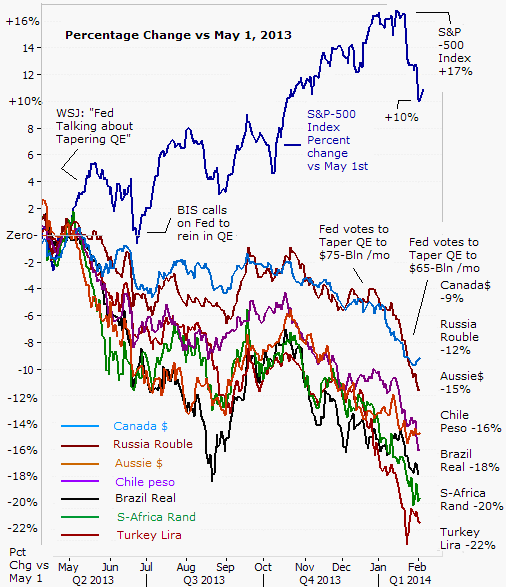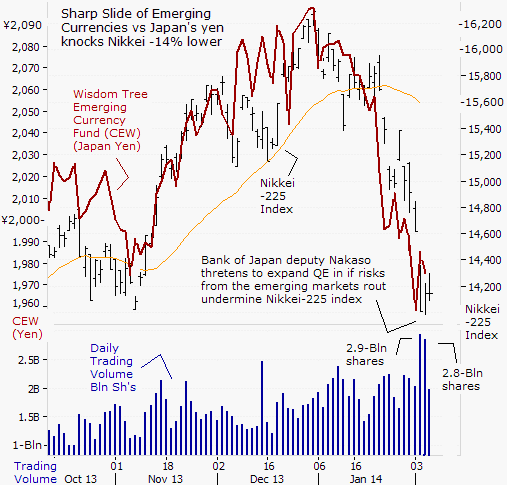|
|||
Global Markets Throw a “Taper Tantrum”Gary Dorsch A sharp sell-off in the global stock markets so far this year has left many small investors a bit puzzled and panicky, and unsure how to react. Retail investors in the US, who watched the from the sidelines in a state of disbelief, as the “Least Loved” Bull market on Wall Street, continued to climb to new all-time highs, - finally decided to throw in the towel in the second half of 2013, and jumped aboard the Bullish bandwagon. The late converts plowed $175-billion of their savings into US-equity funds, helping to push the S&P-500 Index to an all-time high at the 1,850-level. They gave little thought that maybe, the “Least Loved” Bull had climbed “too far and too fast” after gaining +175% from the Great Recession low. January is usually a bullish month for US-stocks. So when the Dow Jones Industrials stumbled out of the gate, sliding -7% so far this year, it raised a warning flag. It means that 2014 will be a volatile year. On Wall Street - the word “Volatility,” is a code word for sharp declines in the market place that are expected to happen frequently. Even if the US-stock market recoups its early losses in the months ahead, it could come under renewed selling pressure again. In other words, the investing landscape has become more treacherous. That’s especially true because the S&P-500 index is fast approaching its fifth birthday on March 9th. And at 59-months old today, the “Least Loved” Bull rally is 4-months beyond the median age of the Top-12 Bull markets in history. As it enters its retirement years, it becomes frail, and more vulnerable to unexpected shocks. Traders that study cycles have also noted that the S&P-500 index hasn’t suffered a correction of -10% or more for 30-months. That’s remarkable, since historically, -10% corrections happen about 20-months apart, on average. Not to forget the stock market will have to deal with the Fed’s dialing back its high octane liquidity injections, a policy shift that will force the QE-addicted stock market to stand on its own two feet. Most traders are completely unaware that the Fed has already started draining excess liquidity on a daily basis, through reverse repo operations. On Feb 4th, the Fed drained $106-billion at 3-bps from 60-bidders. Thus, the Fed is partly sterilizing its QE-injections, which in turn, is helping to support the US$’s exchange rate. Still, investors can expect the “Plunge Protection Team” (PPT) to intervene in the stock index futures markets, whenever panic selling erupts, in order to prevent a disorderly slide from turning into a horrific crash. On February 3rd, the Dow Jones Industrial average plummeted 326-points - continuing the steep sell-off from January. The Dow has shed more than 1,200-points, and its year to date losses total -7.4%, while the broader S&P-500 index plunged to the 1,742-level, and is down about -6%, -- the most it has fallen since its initial Taper Tantrum was unveiled in late May - late June of 2013. The Perma-Bulls on US-equities were caught of guard as were the latecomers to the QE-party, and were surprised by the sharp pullback, because their radar screens weren’t focused on the downturn in the Emerging currency markets.
“A trend in motion will stay in motion, until some major outside force knocks it off its course.” While it’s best to ride the gravy train for as long as possible, contrarians are also mindful to spot the contradictions between the mix of macro-economic data and the mix of the global markets. Such was the case in the fourth quarter of 2013, when a wide mismatch was unfolding. Most notably, - there was a sharp slide in the exchange rates of the Australian and Canadian dollars and the Emerging market currencies, versus the value of the US-dollar, and over the other side of the equation, yen carry traders were bidding up the exchange traded funds linked to the German DAX, Japan’s Nikkei, and the US-stock market indexes. In hindsight, the widening divergence was unsustainable. But contradictions between the real economy and the market can be long lasting. “The market can stay irrational longer than you can stay solvent,” John Maynard Keynes used to say. So the Macro Trader was patiently waiting for a notable change in sentiment before placing a contrarian bet. Market sentiment can change instantly and without warning. As is typical in a Bear raid, - an eight day slide in the S&P-500 index wiped out the gains over the previous 67-trading days. The catalyst for the sharp pullbacks in the German, Japanese, and US-stock markets was the meltdown in the exotic Emerging currencies and even currencies with AAA bond ratings. Since May 1st 2013, - the Turkish lira has plunged -22% lower, South Africa’s rand tumbled -20%, Brazil’s real tumbled -18%, Chile’s peso fell -16%, and the Russian rouble fell -12% against the US$. The Aussie and the Canada’s Loonie tumbled -15% and -9% respectively. There was a notable unwinding of the “yen carry” trade, against the Euro and US$. The Bank of Japan (BoJ) is nursing a yen carry trade that contains hundreds of billions of leveraged bets. Global investors pulled $15-billion from the Emerging stocks and $36-billion from Emerging market bond funds in the second half of 2013. But these trades are just a drop in the bucket, compared to the $4-trillion of foreign funds that was plowed into the emerging markets since the Bank of England (BoE) and the Fed began their QE-schemes in March of 2009. It’s estimated that $440-billion of the BoE’s and the Fed’s “hot money” flowed into Emerging market bonds, equities and liquid instruments that can be sold quickly. With the Fed slowly tightening the money spigots, life will be more difficult for the “Fragile Seven” Emerging countries – Argentina, Brazil, India, Indonesia, Turkey Russia, and South Africa – that account for over 17% of global GDP. Recently, central banks in Asia and Latin America were forced to jack-up their interest rates to stave off currency collapses and a wholesale exodus of foreign investors. Brazil, Turkey, India and South Africa hiked interest rates in January, but whether these steps will steady the currencies is unclear. However, one thing is sure - economic growth, Emerging countries’ main trump card over their richer peers, will take a hit, as a result of the recent upward spiral in their local bond yields. The aftershocks are already reflected in the value of the iShares Emerging Markets ETF (ticker symbol: EEM), its down -15% compared with a year ago, and others have fared worse. The iShares for Turkey ETF (ticker: TUR) is -39% lower, the iShares for Brazil is -31% lower, and Market Vectors Russia ETF (RSX) is -20% lower, - among the worst performers. High Frequency Algo’s Slam Japan’s Nikkei-225 index, Although the dark clouds over the Emerging markets have been gathering force for many months, it wasn’t until January ’14, that the equity markets in the G-7 arena suddenly began to react. Last year, Japan’s Nikkei-225 index had beaten all other benchmarks, it was up +57%, fired-up by Prime minister Shinzo Abe’s all-out campaign to crush the exchange rate of the Japanese yen. The correlation between the booming Nikkei and the weakening yen’s exchange rate was three times the 10-year average. But in what Japan’s economy chief Akira Amariit calls an “excessive reaction” to the Fed’s tapering of QE - the Nikkei-225 index plunged as much as -14% lower to the 14,000-level, since the start of this year.
Tokyo stocks, which rely heavily on fickle flows of money from foreigners, have suffered the third worst start to a year in the past half century. According to the Tokyo Stock Exchange, 70% of the daily liquidity in its main section is driven by foreign investors. Likewise, High-Frequency Trading (HFT) that uses complex algorithms, to transact a large number of trades at very fast speeds account for 70% of the daily trading volume in Tokyo stocks. On Feb 4th, HFT cowboys from the Western world pummeled the Nikkei-225 index, slamming it 610-points lower, or -4.2%, to close at 14,008. Losers trounced winners 1,764 to 13 in the first section, while three issues were unchanged. Volume increased to 2.9-billion shares. On the previous day, the Nikkei was dumped for 295-points. The trigger for the sharp decline was the weakening of the Euro, the US$, and the Emerging currencies against the value of the Japanese yen. In New York trading, the US$ briefly fell to ¥100.77, and with the Euro also slipping towards ¥136 in Tokyo trading, the Nikkei average extended losses late in the afternoon session, hit by unwinding of futures-linked arbitrage positions amid a growing “risk off” mood. The Nikkei Stock Average Volatility Index climbed +10% in a single day, to its highest level since July, indicating that traders were caught flat footed by the turmoil in Emerging currency markets. The Wisdom Tree Emerging Currency Fund (NYSE ticker: CEW) – a basket of equally weighted currencies in Brazil, Chile, Mexico, Hungary, Poland, Turkey, South Africa, China, India and South Korea also plunged by as much as -6% against the Japanese yen from Jan 1st thru Feb 3rd, to ¥1,960 /share, and whipped-up selling in the Nikkei-225 index. The sharp devaluation of the emerging currencies will deliver a double whammy for Japanese exporters, such as Toyota Motor (7203.TK) which derives 42% of its sales in the Emerging markets. However, Tokyo’s financial warlords are monitoring the currency and equity markets 24-hours per day. On February 5th, Bank of Japan deputy Hiroshi Nakaso drew a red-line in the sand, by threatening to increase the size of its ¥7-Trillion /month, QE-scheme, if necessary, to stop the slide of the Euro and US$ against the Japanese yen. “It’s important to steadily proceed with the BoJ’s quantitative monetary easing,” Nakaso told parliament. “But financial markets, including those for Emerging economies, are making jittery movements. If some kind of risk materializes, we will take necessary policy adjustments,” he said. The Jawboning worked. The US$ rebounded to ¥102 the next day, and the Euro jumped ¥2-½ to ¥138, which in turn, ignited +1% rallies for the German DAX and Dow Jones Industrials, while relieving pressure on carry traders to unwind positions in Emerging currencies. There’s a limit to how far Algo traders are able to frustrate Japan’s Ministry of Finance. To read the rest of this article, please click on the hyperlink located below: http://www.sirchartsalot.com/article.php?id=187 ### Feb 6, 2014 |


